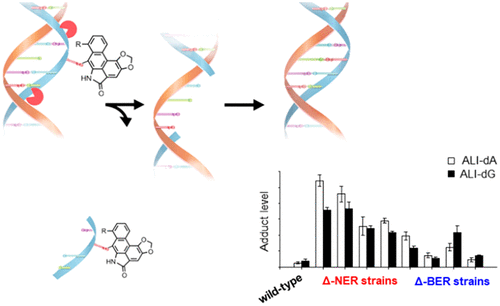当前位置:
X-MOL 学术
›
Chem. Res. Toxicol.
›
论文详情
Our official English website, www.x-mol.net, welcomes your
feedback! (Note: you will need to create a separate account there.)
Quantitation of DNA Adducts of Aristolochic Acids in Repair-Deficient Cells: A Mechanistic Study of the DNA Repair Mechanism.
Chemical Research in Toxicology ( IF 3.7 ) Pub Date : 2020-03-02 , DOI: 10.1021/acs.chemrestox.0c00004 Chun-Kit Au 1 , Chi-Kong Chan 1 , Ka-Ki Tung 1 , Jiayin Zhang 1 , Wan Chan 1
Chemical Research in Toxicology ( IF 3.7 ) Pub Date : 2020-03-02 , DOI: 10.1021/acs.chemrestox.0c00004 Chun-Kit Au 1 , Chi-Kong Chan 1 , Ka-Ki Tung 1 , Jiayin Zhang 1 , Wan Chan 1
Affiliation

|
Accumulating evidence has revealed that nephrotoxic and carcinogenic aristolochic acids (AAs) released from decaying Aristolochia clematitis L. weeds are soil and food grain contaminants in the Balkan Peninsula, while AA toxicity has been linked to induced DNA damage. In this study, we investigated the DNA repair mechanism that excises the aristolactam-DNA adducts in gene-knockout Escherichia coli cells. These results demonstrated that cell lines deficient in nucleotide excision repair (NER) machinery accumulated higher adduct levels, indicating that NER is the major mechanism responsible for the repair of these lesions. Furthermore, data also revealed the involvement of base excision repair enzymes in repairing the lesions but with lower contribution than NER.
中文翻译:

修复缺陷细胞中马兜铃酸DNA加合物的定量:DNA修复机制的机理研究。
越来越多的证据表明,从腐烂的马兜铃菌( L. Aristolochia clematitis L.)杂草中释放出的肾毒性和致癌性马兜铃酸(AAs)是巴尔干半岛的土壤和粮食谷物污染物,而AA毒性则与诱导的DNA损伤有关。在这项研究中,我们调查了基因敲除大肠杆菌细胞中切除马兜铃内酰胺-DNA加合物的DNA修复机制。这些结果表明缺乏核苷酸切除修复(NER)机制的细胞系积累了更高的加合物水平,表明NER是负责修复这些病变的主要机制。此外,数据还显示碱基切除修复酶参与修复病变,但贡献比NER低。
更新日期:2020-03-02
中文翻译:

修复缺陷细胞中马兜铃酸DNA加合物的定量:DNA修复机制的机理研究。
越来越多的证据表明,从腐烂的马兜铃菌( L. Aristolochia clematitis L.)杂草中释放出的肾毒性和致癌性马兜铃酸(AAs)是巴尔干半岛的土壤和粮食谷物污染物,而AA毒性则与诱导的DNA损伤有关。在这项研究中,我们调查了基因敲除大肠杆菌细胞中切除马兜铃内酰胺-DNA加合物的DNA修复机制。这些结果表明缺乏核苷酸切除修复(NER)机制的细胞系积累了更高的加合物水平,表明NER是负责修复这些病变的主要机制。此外,数据还显示碱基切除修复酶参与修复病变,但贡献比NER低。











































 京公网安备 11010802027423号
京公网安备 11010802027423号